Abstract
Background:
The pathogenicity of copy number variations (CNV) in neurodevelopmental disorders is supported by research literature. However, few studies have evaluated the utility and counseling challenges of CNV analysis in clinic.
Methods:
We analyzed the findings of CNV studies from a cohort referred for genetics evaluation of autism spectrum disorders (ASD), developmental disability (DD), and intellectual disability (ID).
Results:
Twenty-two CNV in 21 out of 115 probands are considered to be pathogenic (18.3%). Five CNV are likely pathogenic and 22 CNV are variants of unknown significance (VUS). We have found seven cases with more than two CNV and two with a complex rearrangement of the 22q13.3 Phelan-McDermid syndrome region. We identified a new and de novo 1q21.3 deletion that encompasses SETDB1, a gene encoding methylates histone H3 on lysine-9 (H3K9) methyltransferase, in a case with ASD.
Conclusion:
We provide evidence to support the value of CNV analysis in etiological evaluation of neurodevelopmental disorders in autism genetics clinic. However, interpretation of the clinical significance and counseling families are still challenging because of the variable penetrance and pleotropic expressivity of CNV. In addition, the identification of a 1q21.3 deletion encompassing SETDB1 provides further support for the role of chromatin modifiers in the etiology of ASD.
Similar content being viewed by others
Log in or create a free account to read this content
Gain free access to this article, as well as selected content from this journal and more on nature.com
or
References
Freeman JL, Perry GH, Feuk L, et al. Copy number variation: new insights in genome diversity. Genome Res 2006;16:949–61.
Conrad DF, Pinto D, Redon R, et al.; Wellcome Trust Case Control Consortium. Origins and functional impact of copy number variation in the human genome. Nature 2010;464:704–12.
Schaefer GB, Mendelsohn NJ ; Professional Practice and Guidelines Committee. Clinical genetics evaluation in identifying the etiology of autism spectrum disorders: 2013 guideline revisions. Genet Med 2013;15:399–407.
Miller DT, Adam MP, Aradhya S, et al. Consensus statement: chromosomal microarray is a first-tier clinical diagnostic test for individuals with developmental disabilities or congenital anomalies. Am J Hum Genet 2010;86:749–64.
Manning M, Hudgins L ; Professional Practice and Guidelines Committee. Array-based technology and recommendations for utilization in medical genetics practice for detection of chromosomal abnormalities. Genet Med 2010;12:742–5.
Beaud et AL. The utility of chromosomal microarray analysis in developmental and behavioral pediatrics. Child Dev 2013;84:121–32.
Betancur C. Etiological heterogeneity in autism spectrum disorders: more than 100 genetic and genomic disorders and still counting. Brain Res 2011;1380:42–77.
Devlin B, Scherer SW. Genetic architecture in autism spectrum disorder. Curr Opin Genet Dev 2012;22:229–37.
Sagoo GS, Little J, Higgins JP. Systematic reviews of genetic association studies. Human Genome Epidemiology Network. PLoS Med 2009;6:e28.
Kaminsky EB, Kaul V, Paschall J, et al. An evidence-based approach to establish the functional and clinical significance of copy number variants in intellectual and developmental disabilities. Genet Med 2011;13:777–84.
Thomas NS, Durkie M, Potts G, et al. Parental and chromosomal origins of microdeletion and duplication syndromes involving 7q11.23, 15q11-q13 and 22q11. Eur J Hum Genet 2006;14:831–7.
Piard J, Philippe C, Marvier M, et al. Clinical and molecular characterization of a large family with an interstitial 15q11q13 duplication. Am J Med Genet A 2010;152A:1933–41.
Shen Y, Dies KA, Holm IA, et al.; Autism Consortium Clinical Genetics/DNA Diagnostics Collaboration. Clinical genetic testing for patients with autism spectrum disorders. Pediatrics 2010;125:e727–35.
Coe BP, Witherspoon K, Rosenfeld JA, et al. Refining analyses of copy number variation identifies specific genes associated with developmental delay. Nat Genet 2014;46:1063–71.
Ben-David O, Pewzner-Jung Y, Brenner O, et al. Encephalopathy caused by ablation of very long acyl chain ceramide synthesis may be largely due to reduced galactosylceramide levels. J Biol Chem 2011;286:30022–33.
Sarraf SA, Stancheva I. Methyl-CpG binding protein MBD1 couples histone H3 methylation at lysine 9 by SETDB1 to DNA replication and chromatin assembly. Mol Cell 2004;15:595–605.
Nordgren A, Arver S, Kvist U, Carter N, Blennow E. Trisomy 5q12–>q13.3 in a patient with add(13q): characterization of an interchromosomal insertion by forward and reverse chromosome painting. Am J Med Genet 1997;73:351–5.
Faivre L, Gosset P, Cormier-Daire V, et al. Overgrowth and trisomy 15q26.1-qter including the IGF1 receptor gene: report of two families and review of the literature. Eur J Hum Genet 2002;10:699–706.
Zelante L, Croce AI, Grifa A, Notarangelo A, Calvano S. Interstitial “de novo” tandem duplication of 7(q31.1-q35): first reported case. Ann Genet 2003;46:49–52.
Kant SG, Kriek M, Walenkamp MJ, et al. Tall stature and duplication of the insulin-like growth factor I receptor gene. Eur J Med Genet 2007;50:1–10.
Bonaglia MC, Giorda R, Beri S, et al. Molecular mechanisms generating and stabilizing terminal 22q13 deletions in 44 subjects with Phelan/McDermid syndrome. PLoS Genet 2011;7:e1002173.
Durand CM, Betancur C, Boeckers TM, et al. Mutations in the gene encoding the synaptic scaffolding protein SHANK3 are associated with autism spectrum disorders. Nat Genet 2007;39:25–7.
Sarkar M, Iliadi KG, Leventis PA, Schachter H, Boulianne GL. Neuronal expression of Mgat1 rescues the shortened life span of Drosophila Mgat11 null mutants and increases life span. Proc Natl Acad Sci USA 2010;107:9677–82.
Repetto GM, White LM, Bader PJ, Johnson D, Knoll JH. Interstitial duplications of chromosome region 15q11q13: clinical and molecular characterization. Am J Med Genet 1998;79:82–9.
Miles JH. Autism spectrum disorders–a genetics review. Genet Med 2011;13:278–94.
Tan SL, Nishi M, Ohtsuka T, et al. Essential roles of the histone methyltransferase ESET in the epigenetic control of neural progenitor cells during development. Development 2012;139:3806–16.
Jiang Y, Matevossian A, Guo Y, Akbarian S. Setdb1-mediated histone H3K9 hypermethylation in neurons worsens the neurological phenotype of Mecp2-deficient mice. Neuropharmacology 2011;60:1088–97.
Jiang Y, Jakovcevski M, Bharadwaj R, et al. Setdb1 histone methyltransferase regulates mood-related behaviors and expression of the NMDA receptor subunit NR2B. J Neurosci 2010;30:7152–67.
Cukier HN, Lee JM, Ma D, et al. The expanding role of MBD genes in autism: identification of a MECP2 duplication and novel alterations in MBD5, MBD6, and SETDB1. Autism Res 2012;5:385–97.
Iossifov I, O’Roak BJ, Sanders SJ, et al. The contribution of de novo coding mutations to autism spectrum disorder. Nature 2014;515:216–21.
Cook EH Jr, Lindgren V, Leventhal BL, et al. Autism or atypical autism in maternally but not paternally derived proximal 15q duplication. Am J Hum Genet 1997;60:928–34.
Depienne C, Moreno-De-Luca D, Heron D, et al. Screening for genomic rearrangements and methylation abnormalities of the 15q11-q13 region in autism spectrum disorders. Biol Psychiatry 2009;66:349–59.
Bolton PF, Dennis NR, Browne CE, et al. The phenotypic manifestations of interstitial duplications of proximal 15q with special reference to the autistic spectrum disorders. Am J Med Genet 2001;105:675–85.
Girirajan S, Rosenfeld JA, Cooper GM, et al. A recurrent 16p12.1 microdeletion supports a two-hit model for severe developmental delay. Nat Genet 2010;42:203–9.
Leblond CS, Kaneb HM, Dion PA, Rouleau GA. Dissection of genetic factors associated with amyotrophic lateral sclerosis. Exp Neurol 2014;262 Pt B:91–101.
Sanders SJ, Ercan-Sencicek AG, Hus V, et al. Multiple recurrent de novo CNVs, including duplications of the 7q11.23 Williams syndrome region, are strongly associated with autism. Neuron 2011;70:863–85.
Uddin M, Thiruvahindrapuram B, Walker S, et al. A high-resolution copy-number variation resource for clinical and population genetics. Genet Med 2015;17:747–52.
Sarasua SM, Boccuto L, Sharp JL, et al. Clinical and genomic evaluation of 201 patients with Phelan-McDermid syndrome. Hum Genet 2014;133:847–59.
Soorya L, Kolevzon A, Zweifach J, et al. Prospective investigation of autism and genotype-phenotype correlations in 22q13 deletion syndrome and SHANK3 deficiency. Mol Autism 2013;4:18.
Sarasua SM, Dwivedi A, Boccuto L, et al. Association between deletion size and important phenotypes expands the genomic region of interest in Phelan-McDermid syndrome (22q13 deletion syndrome). J Med Genet 2011;48:761–6.
Miller DT, Chung W, Nasir R, et al. 16p11.2 recurrent microdeletion. In: Pagon RA, Adam MP, Ardinger HH, et al., eds. GeneReviews(R). University of Washington: Seattle, WA; 1993.
Conlin LK, Thiel BD, Bonnemann CG, et al. Mechanisms of mosaicism, chimerism and uniparental disomy identified by single nucleotide polymorphism array analysis. Hum Mol Genet 2010;19:1263–75.
Schaaf CP, Wiszniewska J, Beaudet AL . Copy number and SNP arrays in clinical diagnostics. Annu Rev Genomics Hum Genet 2011;12:25–51.
Author information
Authors and Affiliations
Corresponding author
Rights and permissions
About this article
Cite this article
Xu, Q., Goldstein, J., Wang, P. et al. Chromosomal microarray analysis in clinical evaluation of neurodevelopmental disorders-reporting a novel deletion of SETDB1 and illustration of counseling challenge. Pediatr Res 80, 371–381 (2016). https://doi.org/10.1038/pr.2016.101
Received:
Accepted:
Published:
Issue date:
DOI: https://doi.org/10.1038/pr.2016.101
This article is cited by
-
Epigenetic mechanism of SETDB1 in brain: implications for neuropsychiatric disorders
Translational Psychiatry (2020)
-
Clinical and molecular genetic characterization of familial MECP2 duplication syndrome in a Chinese family
BMC Medical Genetics (2017)
-
Chromosomal microarray analysis in a cohort of underrepresented population identifies SERINC2 as a novel candidate gene for autism spectrum disorder
Scientific Reports (2017)
-
The methyltransferase SETDB1 regulates a large neuron-specific topological chromatin domain
Nature Genetics (2017)



